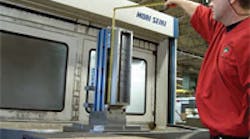Haberman Machine Inc. Oakdale, Minn., uses innovative workholding that is designed to increase productivity.
The company uses dozens of pre-set tower and vise fixtures for quick setups on repeat projects instead of more costly dedicated fixtures. Its work covers the complete spectrum of parts, materials and customers, from tiny medical devices to large defense components. All require precision machining with relatively short-run quantities, frequent setups and the effective use of modular workholding.
To facilitate aggressive metalremoval rates when machining two heavy workpieces, Haberman Machine uses twin customized vises from Kurt Workholding (www.kurtworkholding.com). The vises are mounted vertically and back-to-back on horizontal machining centers to accurately and rigidly center the workpieces over the machine pallet while hogging out large amounts of metal at their center of gravity.
The challenge
The new workholding setup replaced a much slower setup process on vertical machining centers where parts were clamped lying down. In the new setup, the matched Kurt vises both have huge 21-in. jaw openings for vertically clamping large 30-in. by 40-in. steel workblanks weighing over 100 lb.
Also, the workholding setup is designed for use on two different size machine pallets, thus giving Haberman Machine maximum flexibility to machine a wide range of large parts while reducing setup time.
These components are machined out of 8620 steel alloy and are used in a mold system designed by NessTech Concrete Molds Inc. and built by Haberman Machine. Machining these components requires robust workholding to align and rigidly hold the workpieces. Because of their size and weight, operators were challenged to position and clamp these mold components in the machine.
“Standard vises mounted on a tombstone really didn’t work for this type of machining application,” said Scott Ness of Haberman Machine.
“Machining these parts lying down in a vertical machining center required too much setup time, and we were limited with the area we could machine with each setup. We needed a setup that could accommodate machining these long parts in a vertical Z-axis position with enough clearance for machining on both sides. Also, we needed workholding that was flexible for use on two different machines and was relatively easy for operators to handle.”
A flexible answer
Mike Granlund of Kurt’s Custom Engineered Workholding department recommended two Kurt 8-in. wide, extra-long, pull-type, single-station vises: 8XLPTLSS back-to-back.
With this approach the setup is flexible providing the part capacity and rigidity needed plus, it’s easier and less expensive as compared with a custom fixture. In addition to a 21-in. jaw capacity, the vises can be mounted without disassembly or modification to two different horizontal machining centers with different size pallets — a Mori Seiki MH63 with a 630-mm pallet and a Niigata SPN 50-HO with a 500-mm pallet.
The two Kurt vises are bolted with six half-inch Allen nuts and doweled back-to-back. All sides of these vises are machined to a Kurt standard 0.001 in. so they align when mounted back-to-back.
Bolted together, the two vises are mounted on a 500-mm base plate that then mounts to the 500-mm machine pallet. A 630-mm subplate allows mounting directly to the 500-mm base plate that then can be mounted to the second machining center. A 2.250-in. high riser is also used in the setup to achieve the desired spindle clearance for both machine setups.
The subplate, baseplate and riser are sized and machined for this application at less than a fourth of the cost of a tombstone.
The extra-long, pull-type Kurt vises used in this application are made of 80,000-psi ductile iron to provide stability and to eliminate chatter or vibration from the machining process.
Delivering up to 12,000 lb of clamping force, Kurt’s Anglock vises automatically position the workpiece in the vise jaws. As clamping force is applied, the mold workblank is pushed down and onto the vise base to align it accurately.
The Anglock design also resists any tendency for part lift during machining operations. This pulltype clamping design ensures high precision and repeatability.
“The machine operator uses an overhead crane to lower the workblank into the vise clamping area. Once moved into the open jaws, the vise is clamped manually. This new setup consumes a lot less time than the way we were doing it because there are no machining clearance issues as there would be using a tombstone setup, Ness said.
“In addition to eliminating the need for a tombstone, saving us $5,000 to $8,000, we’re not sacrificing clamping rigidity. The fact that we can center workpieces and take advantage of gravity in the setup prevents vibration and tool chatter when making the most aggressive cuts. We’re getting top machine speeds, great finishes and no scrapped parts, thanks to this workholding design,” he added.









